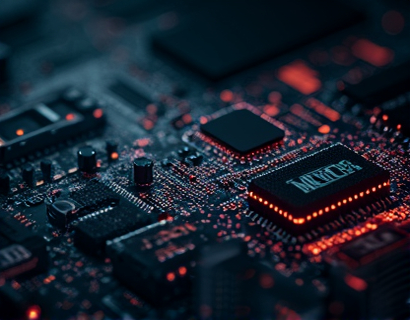Advanced Layer 2 Solutions: Revolutionizing Blockchain Scalability and Efficiency for EVM-Enabled Development
In the rapidly evolving landscape of blockchain technology, scalability and efficiency have emerged as critical challenges for developers, especially those working with Ethereum Virtual Machine (EVM)-enabled platforms. The inherent limitations of Layer 1 blockchains, such as limited transaction throughput and high gas fees, have spurred the development of advanced Layer 2 solutions. These solutions aim to enhance scalability, security, and efficiency, enabling the creation of faster, more secure, and cost-effective decentralized applications (dApps). This article delves into the transformative impact of advanced Layer 2 solutions on EVM-based blockchain development, providing insights for blockchain developers and innovators.
Understanding Layer 2 Solutions
Layer 2 solutions refer to technologies built on top of existing blockchain networks (Layer 1) to improve performance and reduce costs. Unlike Layer 1 upgrades, which involve modifying the core protocol, Layer 2 solutions operate within the existing framework, offloading some of the computational and transactional load. This approach allows for greater flexibility and faster implementation without the need for consensus among all network participants.
For EVM-enabled blockchains, Layer 2 solutions are particularly crucial. The EVM, while powerful, has limitations in terms of scalability and cost efficiency. Transactions on the EVM can be slow and expensive, especially during peak times. Layer 2 solutions address these issues by processing transactions off the main chain, thereby reducing congestion and lowering fees. This not only enhances user experience but also opens up new possibilities for dApp development.
Key Advanced Layer 2 Solutions
Several advanced Layer 2 solutions have gained prominence in the blockchain ecosystem, each offering unique benefits and use cases. Some of the most notable solutions include state channels, sidechains, and rollups.
State Channels
State channels allow multiple parties to conduct a series of transactions off the main blockchain, with the final state being submitted to the blockchain once the channel is closed. This method significantly reduces the number of transactions recorded on the main chain, thereby lowering fees and increasing transaction speed. State channels are particularly useful for applications requiring frequent and small transactions, such as gaming and micropayments.
For EVM-based development, state channels can be implemented using smart contracts that manage the opening, closing, and state transitions of the channel. Developers can leverage existing EVM-compatible platforms that support state channel protocols, ensuring seamless integration with their dApps.
Sidechains
Sidechains are independent blockchains that are linked to the main blockchain, allowing assets to be transferred between the two. This setup enables sidechains to operate with different consensus mechanisms and rules, optimizing for specific use cases. Sidechains can handle higher transaction volumes and lower fees, making them ideal for scaling EVM-based applications.
Developers can create sidechains that are compatible with the EVM, allowing for the deployment of existing smart contracts and dApps. This compatibility ensures a smooth transition and leverages the security and trust inherent in EVM-based systems while benefiting from the scalability of sidechains.
Rollups
Rollups are one of the most promising Layer 2 solutions for EVM-based blockchains. They come in two main types: Optimistic Rollups and ZK Rollups.
Optimistic Rollups bundle multiple transactions into a single transaction on the main chain, with a challenge period allowing anyone to dispute the validity of the transactions. If no challenge is raised, the transaction is confirmed, and the fees are distributed. This approach significantly reduces the load on the main chain while maintaining security through the challenge mechanism.
ZK Rollups, on the other hand, use zero-knowledge proofs to bundle and verify transactions off-chain, submitting a compact proof to the main chain. This method offers even higher throughput and lower fees, as it eliminates the need for a challenge period. ZK Rollups are particularly well-suited for EVM-based development, as they can integrate seamlessly with existing smart contracts and protocols.
Benefits of Advanced Layer 2 Solutions
The adoption of advanced Layer 2 solutions brings numerous benefits to EVM-based blockchain development, transforming the way dApps are built and deployed.
Enhanced Scalability
One of the most significant advantages of Layer 2 solutions is their ability to handle a much higher volume of transactions per second (TPS). By offloading transactions to Layer 2, the main chain is relieved of excessive load, resulting in faster transaction confirmation times and improved overall network performance. This scalability is crucial for dApps that require high throughput, such as decentralized finance (DeFi) platforms and social media applications.
Reduced Costs
Layer 2 solutions significantly lower transaction fees, making blockchain technology more accessible to a broader audience. With reduced gas fees, users can perform more transactions without incurring substantial costs. This cost efficiency is particularly beneficial for microtransactions and frequent user interactions, which are common in many dApp scenarios.
Improved Security
Despite the off-chain nature of Layer 2 solutions, security remains a top priority. Advanced protocols like ZK Rollups provide cryptographic proofs that ensure the validity of off-chain transactions without compromising on security. This dual-layer approach maintains the integrity of the EVM-based ecosystem while enhancing the user experience.
Faster Development and Deployment
Layer 2 solutions streamline the development and deployment process for dApps. Developers can leverage pre-built Layer 2 protocols and tools, reducing the time and resources required to build and launch new applications. This efficiency allows for quicker iteration and innovation, fostering a more dynamic and responsive blockchain ecosystem.
Challenges and Considerations
While advanced Layer 2 solutions offer substantial benefits, there are also challenges and considerations that developers must address.
Complexity and Integration
Implementing Layer 2 solutions can introduce additional complexity into dApp development. Developers need to understand the underlying mechanics and ensure seamless integration with existing EVM-based smart contracts and protocols. This requires a deeper technical expertise and careful planning to avoid potential issues.
Interoperability
Ensuring interoperability between different Layer 2 solutions and Layer 1 blockchains is crucial for a cohesive ecosystem. Developers should consider the compatibility and standards adopted by various Layer 2 protocols to facilitate smooth interactions and data transfer.
User Adoption
For Layer 2 solutions to be effective, they must be adopted by users and developers alike. Education and community support play a vital role in promoting the use of advanced Layer 2 technologies. Developers can contribute to this by creating user-friendly interfaces and providing comprehensive documentation.
Future Prospects
The future of blockchain innovation is closely tied to the continued development and adoption of advanced Layer 2 solutions. As the ecosystem evolves, we can expect even more sophisticated protocols and tools that further enhance scalability, security, and efficiency.
For EVM-based development, the integration of Layer 2 solutions will likely become a standard practice, enabling the creation of more robust and user-friendly dApps. The collaboration between Layer 1 and Layer 2 communities will be essential in driving the next wave of blockchain advancements.
In conclusion, advanced Layer 2 solutions are revolutionizing blockchain scalability and efficiency, particularly for EVM-enabled development. By addressing the inherent limitations of Layer 1 blockchains, these solutions pave the way for faster, more secure, and cost-effective decentralized applications. As the technology matures, developers and innovators will continue to harness the potential of Layer 2 to shape the future of blockchain technology.










































